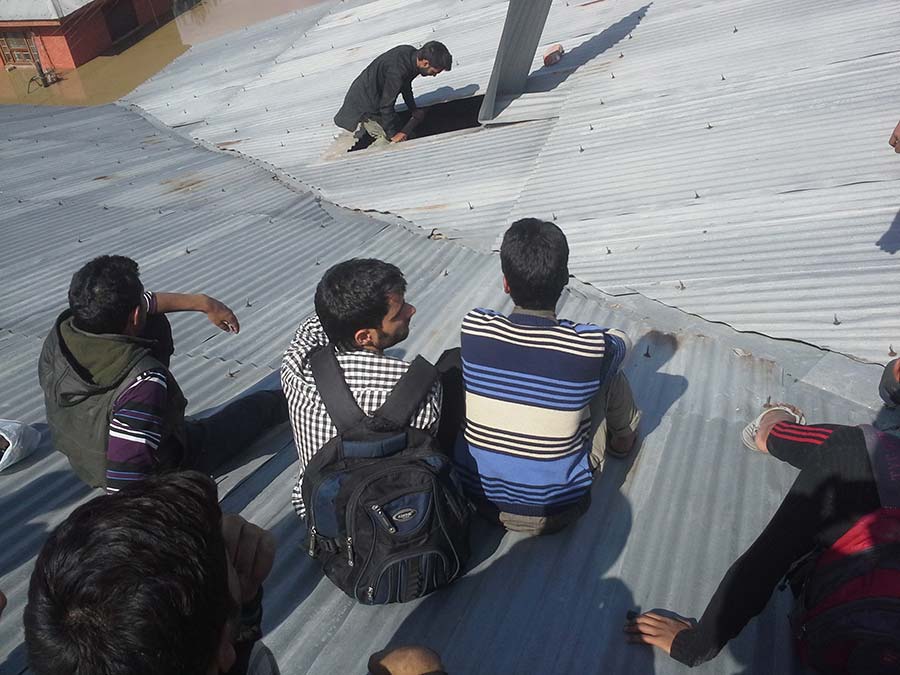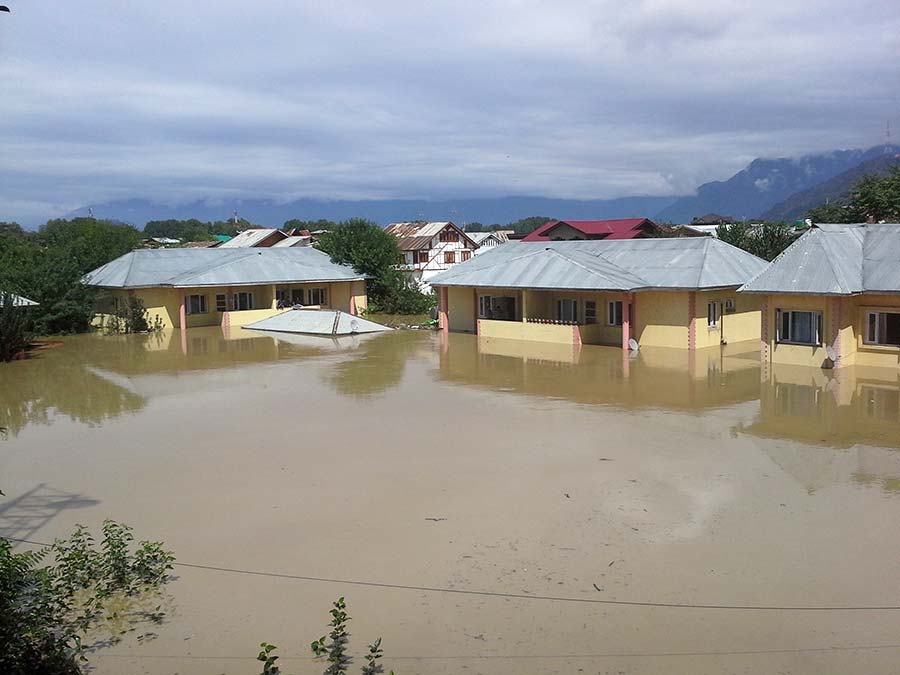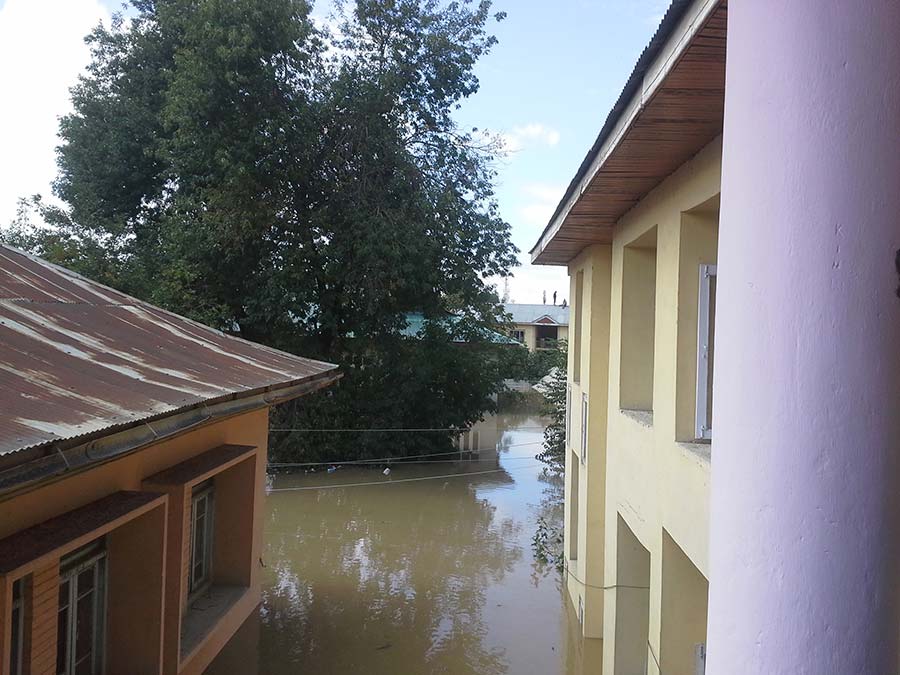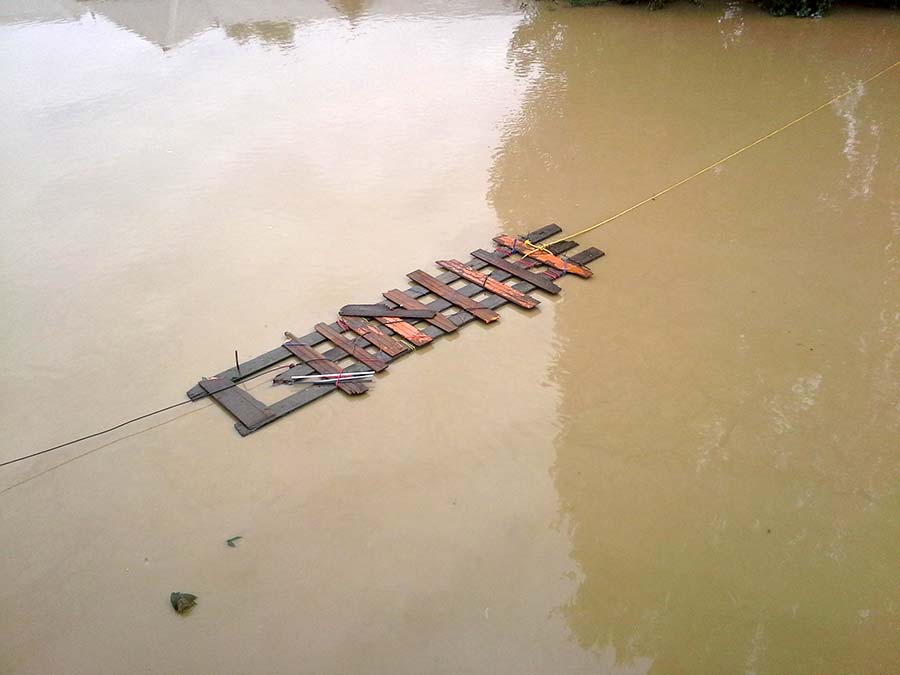For two days sixty boys in the state-run polytechnic were hoping against the hope that they will be rescued. But they failed to even attract the attention of the choppers flying overhead. Finally, they used their poly-technics to float to the FSC bund, three horrifying nights later, reports Umar Mukhtar

On September 6, 2014, Ubaid-ur-Rehman, then 18, and his hostel mates were listing live broadcasts and surfing the internet to check the news breaks about water levels in the Jhelum. Incessant rains for the last many days had swollen the river.
Ubaid was one of the 60-students in the campus hostel of Kashmir Government Polytechnic at GogjiBagh, located on the Maharaja era embankment of the Flood Spill Channel.
Tense and tired, when they woke up next morning, water had begun seeping into the belt. Quickly, their campus was inundated. It was so swift that they found no time to move to safety. Soon, they felt unsafe as the hostel building was an old structure. They decided to shift to one of the academic blocks in the campus, a three-storey concrete structure.
But the level of water was rising fast. They decided to take only essentials items like laptops, academic documents and some blankets. They were desperately waiting for some help. They lost one complete day hoping that some help will come. But it was not coming from any side. By evening the water had risen to nine feet and the ground floor of the academic block was underwater
Ubaid vividly remembers the helpless faces of his friends. Almost everybody was crying. He did not sleep that night. “I was missing my mother,” Ubaid said.
He remembers residents of the Gogjibagh had climbed to the top of their houses and were crying for the help. “Those were heart wrenching scenes,” Ubaid said, “For the entire night, people were crying for help and it was not coming from any side.” Their last hope was their cell phones but the services were dead.

Next morning, on September 8, when they woke up they found the water in the first story too. Quickly, they shifted all their items to the second storey. But the tension was that the levels were still increasing. Ubaid said for the first time they started genuinely feeling that the levels will now chase them to the attic and they all will drown. They started making preparations for paving way for the roof. They broke a portion of the ceiling of the building and made way to the top of tin roof
“The first sight from the roof was terrifying,” Ubaid said. “There was water everywhere. Everything was completely inundated.” He remembers having watched houses collapsing like cardboard blocks and the stinky floods waters carrying costly TV’s, refrigerators, clothes, and utensils. “It was looking like a floating shopping mall but we all were in a state of shock.”
Suddenly, they saw helicopters hovering in the sky and it was a glimmer of hope. They thought the government has sent them for their rescue. “We climbed on the top of the building and started waving at all those choppers but they flew away,” Ubaid said. “Only later, we came to know that they flying for selective rescue.”

By evening the water actually started getting into the second floor. The inmates started evaluating: “one day was lost in waiting for help, another day was lost in crying and waving at flying machines.”
“Our teachers asked us to stay in prostration and beg Allah to forgive our sins,” Ubaid said. “We all knew we were actually dying.” But to fight back for survival is in human nature. Ubaid said as he started hunting for alternatives and did a bit of loud thinking, his senor reprimanded him. Initially, he kept his cool but soon he started aggressively offering his ideas. “We can not die like cowards in this building and do nothing,” Ubaid remembers telling his classmates and seniors. Finally, they agreed to listen to his plan.
Ubaid suggested them to tie him up with the cables that were already present in the building. His plan was to go down and collect the wooden logs, already floating around. He also pulled out the plywood from the ceiling and the doors and converted it into a raft. Somehow they agreed. Cautiously, he fished some logs of wood and parked it near the second floor. Once everything was ready: the logs as well as the playboard, there was nothing to tie the two different kinds of wood up adjoin them to make the raft. It needs long iron nails to join the two.

Ubaid was already the leader of the group that was otherwise lost in the Gogjibagh‘ocean’. He asked his friends to get the electric wires. With this, he tied the logs and after an effort, the raft was ready for the operation.
Now a new crisis emerged. Nobody was willing to ride the boat. Ubaid again took it to himself and rowed the raft into the floodwaters. When his friends saw him in the middle of the flood they were surprised and, for the first time in three day, they started smiling again. “They started calling me with heroic names and were praying for me,” recalls Ubaid.
The raft was ready but it was evening. It was risky to leave the place so they decided against rowing ashore. “I danced on the raft to reassure them that it was perfectly safe and that I was completely fearless and can row them to safety,” Ubaid said.
Since the entire group was hungry for many days, without even water, they decided to check the hostel kitchen for some leftover. Ubaid decided to row the boat to the hostel and he took his friend Omair with him. It triggered a crisis. It was a jerk in the raft while rowing that a scared Omair jumped into the waters. Fortunately, he got hold of a nearby tree and clung to it. The raft had absorbed a lot of water and was about to sink. Ubaid rowed back to the academic block leaving Omair on the tree. He then made a new plan of bringing Omair back.
Ubaid sought the help of the group in tying the raft with the electric cables and with this support; he rowed back and rescued his friend. “Omair was weeping and crying for help. I had promised him that I will come back,” recalls Ubaid. “When we came back, almost everybody hugged us and all cried.”
All were empty and thirsty. But instead of food, reaching a safe place was the priority. “Such was the state of hunger that we once risked our lives to fetch a box of eatables which was flowing in the floodwaters,” says Ubaid.

But they did not sleep. For the whole night, Ubaid and his team worked on a bigger raft. By wee hours, they succeeded in creating raft that could take many people to a long distance.
With the crack of dawn on September 9, Ubaid and the mates began to row the boat towards the Bund, a safer place. The water level that time was touching the second floor. Two persons at a time used to ride the boat and were rowing towards the bund some hundred meters away from the academic block.
“Those moments would live with me forever,” Ubaid, who is now doing his BE (mechanical) in SSM college of engineering and technology, said. “It taught me the lesson that hope does not lie outside us, but inside us.”















